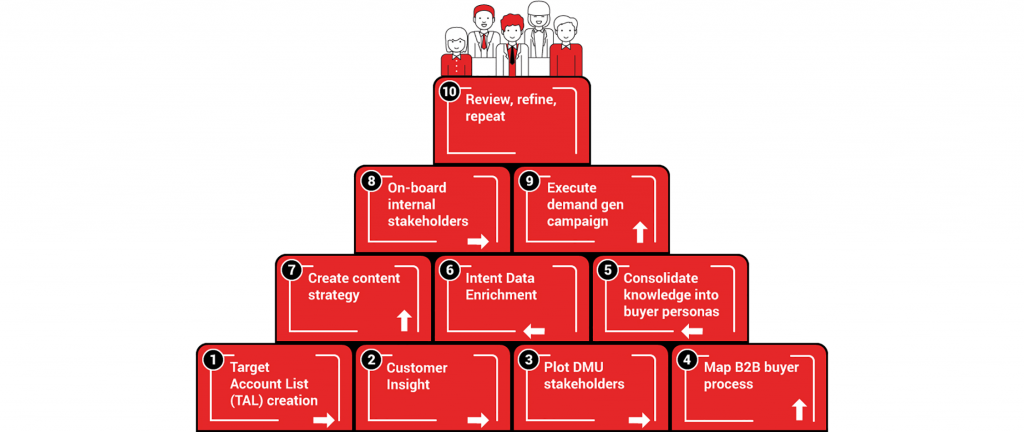Drive repeatable success, whatever your account based marketing approach with this step-by-step process guide…
Reading time: 4 minutes
Whether you’re in the early stages of deploying an account based marketing strategy, planning a scaled down account based marketing pilot or are in the midst of a fully-fledged ABM program, we have a water-tight methodology that you can pit your planning against.

Step 1. Target Account List (TAL) creation
The success of your account based marketing strategy depends on the quality of your research. 88% of senior B2B marketing professionals have seen an improvement in conversion rates when using ABM. However, this will only be true if you target the right companies for your product or service offering.
Regardless of whether your chosen strategy is to grow existing customers or acquire new ones, your first party data is a great place to start.
Not every customer can be neatly matched to a category. However, identifying salient characteristics that naturally segment your data into meaningful audiences will enable you to better pinpoint their profile, pain points, and needs – essential for designing the most effective communications for profitable engagements.
Make a start through interrogating your CRM with the following:
Which customer segments provide:
- The most reward and least effort to acquire and retain?
- The most kudos (high profile brands with high market influence…etc.)?
Which customer segments provide:
- The most effort and least reward?
- The least kudos (low influence, low market presence…etc.)?
Which customer segments:
- Best match your internal capabilities?
- Would require modifying your market offering and value proposition?
These questions alone help form the rationale behind your target account selection. However, remember:
DISCIPLINE IS KEY: STICK TO YOUR SELECTION CRITERIA
Your segmentation rationale is integral to your targeting strategy. It’s the justification for pursuing certain accounts over others. Therefore, in order to keep your ABM strategy on track, you must stay focused.
If your strategy isn’t working, then it’s time to re-think your selection criteria.
And remember, customers may be prime targets for remarketing, too.
If your strategy is focused on new customer acquisition account modelling, or lookalike marketing, is a great tactic for finding new audiences. There are many tools that offer this analysis, including Facebook and Google. Their products are called Lookalike audience and Similar audience.
For example, by analyzing what makes an account attractive to your business and using this insight to spot other accounts that share these same salient characteristics, you can expand your target audience without diluting relevance to your key market offering.
For best results, pay careful attention to your seed audience. Then test, test, test.
Step 2. Customer insight
One of the advantages of Account based marketing is to more closely align sales and marketing. Businesses with aligned sales and marketing functions grow their revenues 24% faster than their peers, while their customer retention is also 36% higher (LinkedIn).
So make a start by speaking to your sales team about who they would like to target, then supplement with your own research.
Some target accounts may look great on paper but demand a lot of resource to win and retain their business. By gaining a perspective from both the sales and marketing side, you can get a better understanding of where your most attractive opportunities lie.
Step 3. Plot DMU stakeholders
Creating a target-account list (TAL) is an important step. However, it’s no guarantee of success. A common pitfall of account based marketing campaigns is to target only the main decision-maker. This completely ignores the wider team, placing key influencers on the periphery while draining resources on notoriously difficult contacts to reach.
Engaging all members of the decision-making unit (DMU) is key to building strong internal support for a deal.
This means considering multiple stakeholders and creating ABM content relevant to their roles, priorities, and perspectives. Can you win advocates amongst potential product users? It could make a crucial difference in a competitive bid scenario.
Further reading: The B2B Decision Making Unit (DMU); The Real Faces of Persuasion
Step 4. Map the B2B buyer process
Growing complexity is a common characteristic of the modern B2B buyer decision process. Taking the time to understand the steps your target stakeholders go through before making a purchasing decision is crucial to designing effective marketing communications.
Far from a linear process once represented in dated marketing models, stakeholders commonly jump back and forth stages, seeking a range of information to satisfy their pain points, queries or buying criteria.
Step 5. Consolidate knowledge into buyer personas
Vetted target account list? CHECK. Gathered accurate insights into the buyer decision process and DMUs? CHECK.
Now it’s time to transform this data into actionable buyer personas. These profiles will ensure you keep your customers at the heart of your communications, improving personalization and relevancy.
We’ve dedicated a whole article to turning your customer insights into accurate B2B buyer personas.
Further reading: B2B DMU Buyer Persona Cheat Sheet
Step 6. Intent Data enrichments
Consider what each stage of the buying journey looks like in intent data. What content is relevant for each stage and persona? How can you leverage the different types of intent data to create or sustain interest in your solution?
Intent data can elevate your targeting efforts through layering rich insights that help drive response and engagement with enhanced precision and accuracy.
Through combing data points and leveraging strategic partnerships, historically hard to reach audiences are instantly accessible.
Step 7. Create content strategy
You should now be armed with your target account list, buyer personas and a map of your buyer decision journey.
The next step is to create a content strategy. What content will you produce and how will it satisfy the needs of your newly discovered target audiences?
Your B2B content strategy should address the following:
- Content topics and themes (directly addressing audience information needs/pain points)
- ToV (This may vary from stakeholder to stakeholder)
- Content types and formats
- Channel amplification mix
- Action plan (internal resources needed, allocated tasks, assigned KPIs)
Recommended reading: B2B Marketing Plan; A Compelling Case for B2B Content Marketing
Check the health of your online resources with this free content audit, request yours now.
Step 8. On-board internal stakeholders
Long-term customer engagement is the name of the game when it comes to executing a successful ABM strategy. In order to achieve this, it is vital all your internal stakeholders are onboard.
From initial engagement right through to post purchase aftercare, you need to sustain a consistent level of quality that superiorly fulfils the needs of your customers. Failure to do so will result in a high customer churn rate.
By getting all your departments working on the same page will help unify your efforts and provide a high level of customer service. Especially through:
- Keeping everyone informed through regular meetings and updates
- Maintaining regular training around your brand values and service standards
Step 9. Execute coordinated demand generation campaigns
The secret to high performing campaigns is ensuring the right message goes to the right audience at the right time, in the right way.
Formulating a plan of attack based on all the knowledge you’ve gathered through the previous process stages should stand you in good stead.
If you’re using channel partners and suppliers to execute campaigns on your behalf be mindful of the following:
- Flexibility: can they tailor your campaign to meet your specific requirements?
- Engaged Audiences: have you got confidence in their ability to reach and engage the right type of leads?
- Dedicated Account Managers: have you been allocated a reliable point of contact who understands the ins and outs of your strategy as well as you do?
- Integration: have you got options over how you will receive lead updates or reports?
Step 10. Review, refine, repeat.
Continuous improvement; it’s what all marketers should be striving towards. Setting KPIs against each activity is best practice as it allows you to keep track of your campaigns.
The most successful campaigns maintain a nimble approach and are quick to respond to shifts in trends and behaviors. Keeping your finger on the pulse of key audience data points such as intent data and buyer signals will help you sustain confidence in the relevancy of your campaigns.
Was this article useful?
If you’re planning to run a ABM strategy we have further support available, contact us now.






